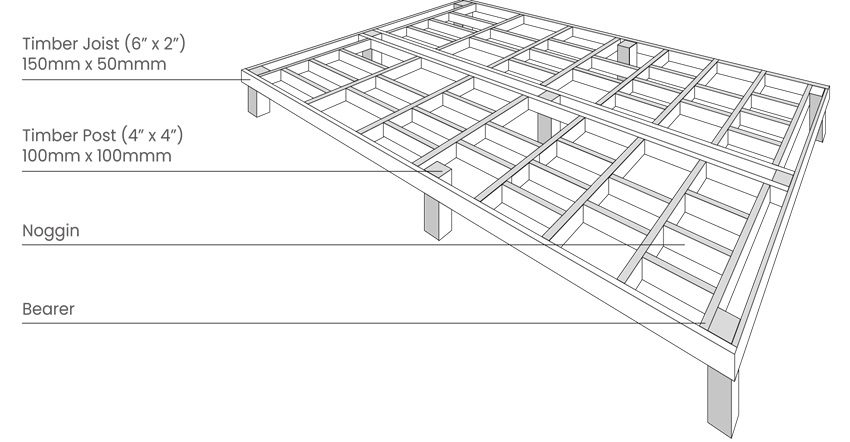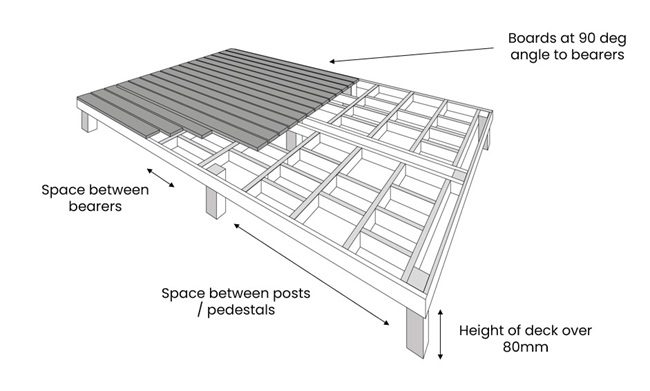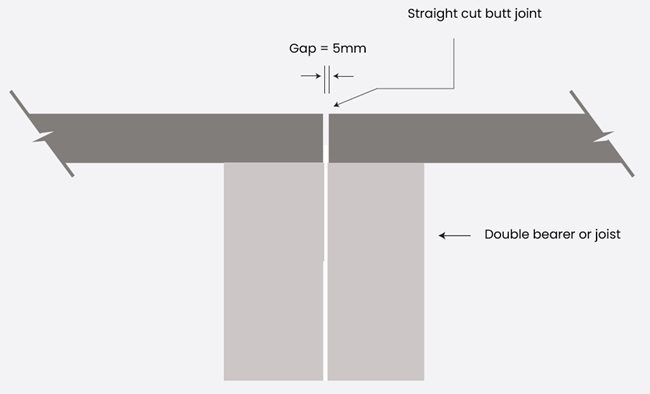Composite decking is a popular choice for homeowners seeking a durable, low-maintenance alternative to traditional wood decks. But to ensure your composite decking stands the test of time, you need to start with a solid foundation. It’s imperative that the base of your deck is structurally sound, secure, and safe.
In this blog post we’ll walk you through the various elements that make up a composite subframe, and the key considerations when building it.
What makes up a composite decking frame?
A traditional, basic composite decking frame is made up of decking joists to create the outer frame and bearers and noggins to add strength and support. These are installed in a parallel matrix using posts to connect them and create the composite decking subframe.

The length, width and height of your frame will be determined by the size and shape of your decked area. The spacing between joists, bearers and posts will be determined in the installation instructions of your deck boards and will vary from manufacturer to manufacturer.
What materials can a composite decking subframe be made from?
Timber, composite and aluminium are the most popular materials used to construct a decking subframe. There are advantages and disadvantages to all three options which are discussed in more detail in our post: What base do I need for composite decking? Your guide to composite decking frames.
Top 5 things to consider when building your composite decking base
1. Your deck needs height for ventilation
Most composite decking requires space beneath it to allow for airflow and drainage (for Ecodek this is 80mm minimum). Air gaps and ventilation are essential to the longevity of the installation and the boards themselves.
This means the subframe should never be placed directly onto a concrete or soil surface – it requires posts or pedestals to lift it off the ground. Read your installation instructions for ground clearance measurements specific to your decking.
2. Consider the direction of bearers right at the start
Your bearers should be laid in the opposite direction to your deck boards which will be laid on top. It’s therefore important to decide on the direction of your boards, before beginning to construct your base!

3. Pay attention to the spacing of joists and bearers
When it comes to fitting your joists and bearers, remember there’s a maximum space you can leave between each one, in order to ensure the strength of your frame.
When consulting your installation instructions you’ll often see this referred to as ‘joist centres’ – this means the space between the centre of one joist (or bearer) and the next.
You can reduce the width and use more joists, which is sometimes recommended when using timber or when building for a heavier load, such as a hot tub. But never go above the maximum recommended spacing.
4. Pay equal attention to the spacing of the posts or pedestals
Again, to understand the recommended spacing between posts or pedestals, you should read your installation guidelines. You will find there are maximum recommended support widths, which differ based on whether they’re supporting composite, aluminium or timber joists and bearers. You can, of course, reduce the width, but never go beyond the recommendation.
5. Don’t underestimate your number of bearers
It’s good practice (and recommended in our installation guide) that any boards that are butted up against each other (butt joints) should be supported by a full-length double bearer. Also – don’t forget to leave a gap between butted boards, for composite expansion and contraction.

Discover how Ecodek can help with your decking needs
If you’d like further help and guidance on how to build the right base for your new decking, call our expert, friendly team today on 01978 667 840 for an informal, no obligation chat. Find out more about the composite decking on offer at Ecodek now and choose from our wide range of decking boards including Wide PVC decking.
